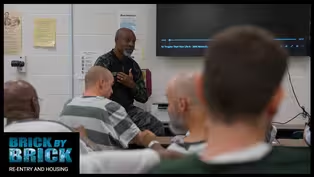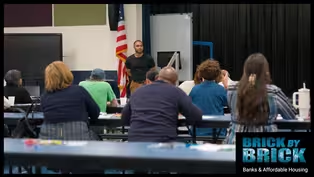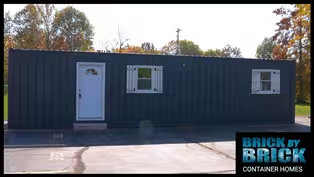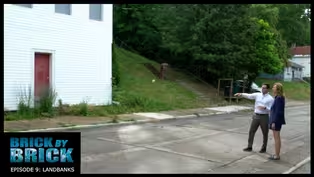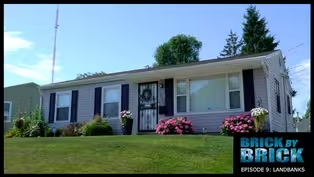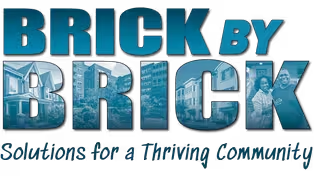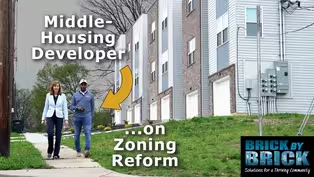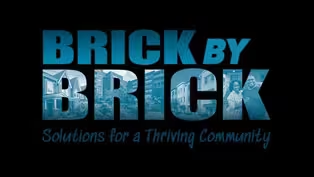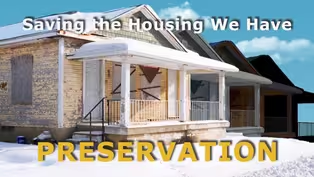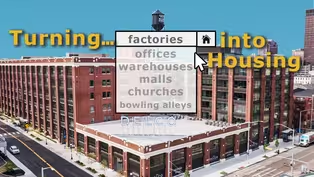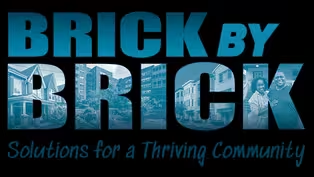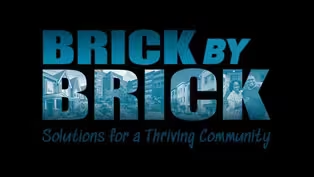
Zoning Reform Addressing the Invisible Barriers in the U.S.
Clip: Season 1 | 9m 16sVideo has Closed Captions
City planners from Tulsa, Buffalo, & Minneapolis detail their cities' zoning reform.
All across the United States, cities are looking at the possible changes they can make to their zoning laws to increase the housing supply. For this episode, we spoke to city planners from Tulsa (OK), Buffalo (NY), and Minneapolis (MN) to see how changes to single family only zoning laws affected their cities.
Problems playing video? | Closed Captioning Feedback
Problems playing video? | Closed Captioning Feedback
Brick by Brick is a local public television program presented by CET

Zoning Reform Addressing the Invisible Barriers in the U.S.
Clip: Season 1 | 9m 16sVideo has Closed Captions
All across the United States, cities are looking at the possible changes they can make to their zoning laws to increase the housing supply. For this episode, we spoke to city planners from Tulsa (OK), Buffalo (NY), and Minneapolis (MN) to see how changes to single family only zoning laws affected their cities.
Problems playing video? | Closed Captioning Feedback
How to Watch Brick by Brick
Brick by Brick is available to stream on pbs.org and the free PBS App, available on iPhone, Apple TV, Android TV, Android smartphones, Amazon Fire TV, Amazon Fire Tablet, Roku, Samsung Smart TV, and Vizio.
Providing Support for PBS.org
Learn Moreabout PBS online sponsorship- Across the country, cities are seeing zoning laws as invisible barriers.
For years, zoning has restricted divided communities along racial lines, concentrated wealth and poverty in certain areas, and has constricted the housing supply.
I had the opportunity to sit down with the housing advocate and city planner in Minneapolis, Minnesota, and city planners in Tulsa, Oklahoma, and Buffalo, New York as well.
They have been on the forefront of zoning reform in our country, and they shared with me how changing the types of housing they can put on their land has affected their cities.
Take a look.
- Single family zoning is really a, a mandate and it's a mandate that every home built in that neighborhood be the most expensive kind of home possible.
- Yana Fand, co-founder of Neighbors from our neighbors in Minneapolis, has been working in housing since the late nineties.
- It's the zoning that makes us lose the opportunity to have really interesting and robust neighborhoods - While working at a Drop-in after school program, Yona noticed some kids would stop showing up - And whenever I asked what happened, invariably it went back to something about housing insecurity.
- Like Cincinnati single family zoning was making it hard for residents to find housing they could afford in Minneapolis.
So in 2018, as one part of the 2040 comprehensive plan, Minneapolis became the first American city to eliminate single family zoning planning director at the city of Minneapolis.
Meg McMahon words it differently.
- We talk about it more as really increasing the opportunities for choice in neighborhoods and allowing for different and, and a more greater variety of types housing products.
- According to McMahon, the legalization of multi-family housing has been underwhelming, - But really, I think in the broad scheme of things, it it hasn't been the most impactful change that we've made - Despite that there have been some small impacts they can attribute to zoning reforms.
- I do think we've seen that the land use reforms on a whole have helped increase the supply of housing in Minneapolis, and I think we've seen that the effect of that has had a downward pressure on market rents.
I think it's probably too soon to be really specific about, you know, which reforms have had the most impact.
- One of the challenges McMahon points to is the building code.
Why you can now build duplexes than triplexes anywhere.
Developers still have to fit them in size and scope within the parameters of a typical single family lot.
- When you're developing single or two family housing, it falls under the residential building code, but anything that's three units are above is under the commercial building code, - Which makes it tough for developers because there's a knowledge gap between single and multifamily.
And honestly, developers across the country have been focused on single family housing for so long that doing anything else is foreign.
- I think we're still figuring it out.
- Chris Hawley, senior planner of the Division of Planning and Zoning in Buffalo, New York, says our developers need more experience with multifamily housing to be the most effective in creating these homes.
- I think it'll take some time ultimately for our finance system, for conventional developers to catch up and produce different types of housing that that fit our community's needs better than the one size fits all.
Single family and multifamily we typically see developed all over the country - Since 2010.
Buffalo has worked on their zoning reform known as the Green Code.
It was officially adopted in 2017 with a citywide approach like Minneapolis, but different to how Cincinnati's approaching connected communities during those seven years and more than 200 meetings, city planners incorporated a zoning reform that resulted in, - We saw a significant influx in mixed use projects, in particular in multiple units over shopfronts in our, our, what we called our, our neighborhood centers, our mixed use main streets and, and a lot more multi-family and residential neighborhoods.
- Buffalo didn't eliminate single family zoning.
Only 4% of the city is now zoned for single family only.
In the other 96%, they're creating more housing options.
- It's worked out pretty well and there are still some regulatory barriers we'd like to revisit within residential zones in particular, but there are no density restrictions any longer along our mixed use zones, our neighborhood centers and within our downtown, and that's where we've seen the, the, the bulk of our new investment - Like Buffalo Cincinnati is also planning to reduce density, setback, and height restrictions around business districts to spur investment.
Buffalo took the citywide approach, but Tulsa, Oklahoma took an approach more like Cincinnati's connected communities with their neighborhood info overlay.
Tulsa City planners like principal planner Nathan Foster, conducted a housing study to address the various communities and their needs.
- What can we do to open up these housing types that we so desperately need and that these neighborhoods have told us they would be open to in their neighborhood?
- So in those study boundaries, developers could build duplexes, townhomes, triplexes, cottage houses or apartments up to a certain scale without having to go through any kind of zoning change or special approval process.
What you would think would speed up the process.
Right.
- So it's a slow unrolling.
I think we've certainly seen duplexes take off.
The amount of multifamily units we've seen has been a little bit slower.
I think we've probably seen two to three projects come outta the ground that were maybe four or six units.
- The slow roll has been a surprise to supporters of the reform and non-supporters alike.
- During our public discussions, I think the neighbors thought the minute this thing was adopted, all the single family homes were coming down and nothing but apartments were gonna be lining the streets.
And that's just not the, I think, economic reality of any of it.
- Developers and planners tell us these investments in housing take time to mature anywhere from two to five years to show impact.
However, they're confident that the barriers being broken down by reforms like these will produce more housing in the - End.
So I expect we'll continue to see more interest and, and certainly some more development, especially as, as potentially construction costs might come down and, and people might be able to, to reengage on some of those projects they were interested in.
- So we're seeing a variety of results in these three cities when it comes to land use reform, but there's another zoning change that is having the most impact.
- If you talk to people about zoning reform, parking is probably at the top of most lists.
- The elimination of minimum parking requirements was the single and most profound, I think, reform that w that was undertaken in the code more than I think anything - Else.
It has been immensely impactful, has been the elimination of minimum parking requirements citywide - And it's good to remember the people that are affected by these zoning laws.
Yana Flesh RAN has seen the effects that barriers in zoning have on residents and their housing options.
- The folks who are members and neighbors from more neighbors are often folks who are 25 to 35 and they're feeling really squeezed oftentimes between being priced out of the neighborhoods they grew up in, being priced out of any sort of first time home ownership and not wanting to be the mechanism.
Gentrifying neighborhoods, - Regardless of the city.
Zoning reform may not be a quick fix to remedy decades of barriers in housing.
However, the current changes are offering more opportunities for residents like the ones in Minneapolis, - And they are seeing that the work we've done over the last six years is shifting things in Minneapolis and they are better able to find the kind of homes that they wanna live in.
So those folks are excited about what's happening.
- The main thing I took from these cities is that zoning reform in general could be a slow process.
Developers need to be on board so they can offer their input to avoid obstacles like the building code issues Minneapolis is dealing with.
Tulsa is working with developers on projects as they wait to see if construction costs go down.
And even though a city like Buffalo's having success, even their city planner stated that they're still getting used to creating multifamily housing.
On top of that, there's one thing we didn't mention politics like many other issues, zoning reform has its opponents and supporters, so taking their perspectives from both sides slows down the process a bit more.
A great example is Minneapolis's elimination of single family only housing.
That ordinance is still being held up in court, which is slowing down their rollout for Brick by Brick.
I'm Hearns Lagar, Jr.
Can land trusts help provide affordable housing?
Video has Closed Captions
Clip: S1 | 6m 20s | Groups in Yellow Springs & Cincinnati, Ohio, use land trusts to make homes affordable. (6m 20s)
Is there a pathway to housing for the formerly incarcerated?
Video has Closed Captions
Clip: S1 | 6m 19s | A successful reentry into society depends on stable housing. (6m 19s)
Is Homeownership Right for Me?
Video has Closed Captions
Clip: S1 | 5m 44s | Banks & other organizations help Dayton residents figure out a path to homeownership. (5m 44s)
Container Homes: A Possible Solution for Affordable Housing
Video has Closed Captions
Clip: S1 | 4m 32s | Shipping containers are being transformed to provide housing. Can they be affordable? (4m 32s)
The Port's restoration process in Sedamsville is Underway
Video has Closed Captions
Clip: S1 | 3m 49s | Vice President of the Port gives us a walkthrough of the rehabbed homes in Sedamsville. (3m 49s)
The Montgomery Landbank Revitalizes homes in Pineview
Video has Closed Captions
Clip: S1 | 4m 15s | The Montgomery County Landbank helps stabilize the housing market with work in Pineview. (4m 15s)
A Housing Solution Right in our Backyard
Video has Closed Captions
Clip: S1 | 6m 34s | Two Cincinnati residents share their experience building an accessory dwelling unit. (6m 34s)
How Reducing Parking Minimums could Maximize the Opportunity
Video has Closed Captions
Clip: S1 | 7m 55s | Camp Washington navigates their paring and provides a test case for Cincinnati. (7m 55s)
Right to Counsel: Balancing the Courtroom
Video has Closed Captions
Clip: S1 | 8m 25s | A Dayton tenant details her experiences facing eviction with and without an attorney. (8m 25s)
Middle Housing Developer... on Cincinnati's Zoning Reforms
Video has Closed Captions
Clip: S1 | 4m 6s | As Cincinnati looks to change its zoning laws, one middle housing developer shows support. (4m 6s)
Zoning Reform Addressing the Invisible Barriers in the U.S.
Video has Closed Captions
Clip: S1 | 9m 16s | City planners from Tulsa, Buffalo, & Minneapolis detail their cities' zoning reform. (9m 16s)
Adaptive Reuse: The Barrister offers Affordable Housing
Video has Closed Captions
Clip: S1 | 9m | OTRCH and Urban Sites turn an office building into affordable apartments in Cincinnati. (9m)
Adaptive Reuse: The Grant Deneau Tower
Video has Closed Captions
Clip: S1 | 6m 32s | The Windsor Companies turns a mid-century modern office building into luxury apartments. (6m 32s)
Affordable Housing Solution: The Port's Approach
Video has Closed Captions
Clip: S1 | 10m 6s | A married couple and an army vet share their journey to finding affordable homeownership. (10m 6s)
Promo: Container Homes Solution
Video has Closed Captions
Preview: S1 Ep6 | 25s | They've been used for shipping, but can industrial containers also be a housing solution? (25s)
Video has Closed Captions
Preview: S1 Ep5 | 30s | Preview for the Brick by Brick team's upcoming episode on preservation in housing. (30s)
Video has Closed Captions
Preview: S1 Ep4 | 25s | Southwest Ohio is a leader in upcycling its buildings. Housing solution: adaptive reuse. (25s)
Promo: Housing Choice Vouchers Re-Examined (Promo)
Video has Closed Captions
Preview: S1 Ep2 | 30s | Re-examining the largest federal rental assistance solution. How well is it working? (30s)
Promo: Housing & Data Analytics (promo)
Video has Closed Captions
Preview: S1 Ep1 | 30s | The Brick by Brick team explores a new housing solution: preventative data analytics. (30s)
Providing Support for PBS.org
Learn Moreabout PBS online sponsorship
- News and Public Affairs

Top journalists deliver compelling original analysis of the hour's headlines.

- News and Public Affairs

FRONTLINE is investigative journalism that questions, explains and changes our world.
Urban Consulate Presents











Support for PBS provided by:
Brick by Brick is a local public television program presented by CET

